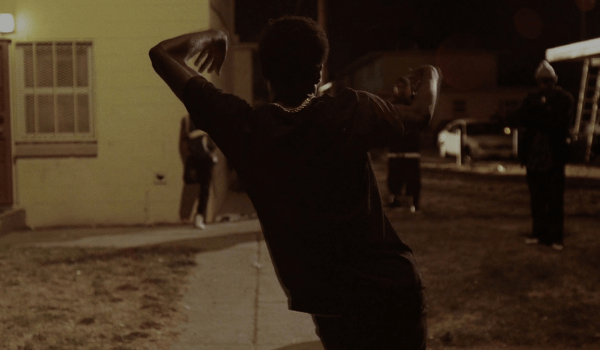Beyond the World’s End: Screening Program
Del Mar Theater, Santa Cruz
March 4, 11, and 18, 2020
How are moving-image artists envisioning radical futures grounded in the traditions of the oppressed? How might we envisage worlds-to-come foregrounding social justice and multispecies flourishing? How can we escape the resounding catastrophism of the dystopian present in giving form to creatively imagining the not-yet, as a radical source of rupture thrown into the future but rebounding in a subsequently transformed present? This film series assembles a diverse group of visionary practitioners whose films offer points of light in a dark world.
Shown in conjunction with the exhibition Beyond the World’s End at the Santa Cruz Museum of Art & History, this film series is part of a year-long research and exhibition project and public lecture series. Directed by T. J. Demos of the Center for Creative Ecologies, this series brings leading international thinkers and cultural practitioners to UC Santa Cruz to discuss what lies beyond dystopian catastrophism, and how we can cultivate radical futures of social justice and ecological flourishing. Funded by the Andrew W. Mellon Foundation John E. Sawyer Seminar on the Comparative Study of Culture. For more information visit BEYOND.UCSC.EDU
Program 1 (67.94 min), Wednesday, March 4, 2020
Black Audio Film Collective (UK), The Last Angel of History, 1995 (45min)
One of the most influential video-essays of the 1990s, this cinematic essay posits science fiction (with tropes such as alien abduction, estrangement, and genetic engineering) as a metaphor for the Pan-African experience of forced displacement, cultural alienation, and otherness. The analysis is rooted in an exploration of the cultural works of Afrofuturist artists, such as funkmaster George Clinton and his Mothership Connection, Sun Ra’s use of extra-terrestrial iconography, and the connections drawn between these issues in the writings of black science fiction authors Samuel R. Delaney and Octavia Butler.
Kahlil Joseph (US), Until The Quiet Comes, 2012 (3.49 min)
An amalgam of the work of director Kahlil Joseph, composer Flying Lotus and dancer and choreographer Storyboard P, this video wordlessly narrates the ubiquitous and rarely spotlighted story of urban violence, resilience, community and creativity. While the killings of Sean Bell, Oscar Grant, and Trayvon Martin provoked temporary national attention, ultimately the incident of a murdered black man (or the countless who are doomed to be imprisoned despite their intelligence, creativity, talent, kindness or youth) continues to remain overlooked—or worse, recognized and accepted as an unalterable fact.
Black Quantum Futurism (US), Time Travel Experiments, 2017 (9.03 min)
Time Travel Experiments is based on a time travel manual embedded in the novel Recurrence Plot (and Other Time Travel Tales), a book of interconnected time travel stories written and self- published by Rasheedah Phillips in 2014, with a soundscape created by Moor Mother, who together form Black Quantum Futurism. BQF is a new approach to living and experiencing reality by way of the manipulation of space-time in order to see into possible futures, and/or collapse space-time into a desired future in order to bring about that future’s reality. This vision and practice derives its facets, tenets, and qualities from quantum physics and Black/African cultural traditions of consciousness, time, and space. BQF’s work focuses on recovery, collection, and preservation of communal memories, histories, and stories.
Danis Goulet, (Cree/Métis), Wakening, 2013 (9 mins)
In the near future, the environment has been destroyed and society suffocates under a brutal military occupation. A lone Cree wanderer Weesakechak (the benevolent cultural hero and trickster of the Cree tribe) searches an urban war zone to find the ancient and dangerous Weetigo (Weetigo (terrifying cannibal spirit of Cree traditional lore) to help fight against the occupiers.
Woodbine collective (US), Coordinates, 2018 (6.37min)
This short essay film from anarchist collective Woodbine addresses the state of contemporary catastrophism, a planet increasingly screen-captured and AI obsessed racing toward extinction. “Against the end of the world,” this is the time for mass revolt, the art of existence, inventing radical models of futurity based within collective struggle.
Program 2 (66.06 min), Wednesday, March 11, 2020
Karrabing Film Collective (Aboriginal/Australia), The Mermaids, or Aiden in Wonderland, 2018 (26.29 min)
In the not so distant future, Europeans will no longer be able to survive for long periods outdoors in a land and seascape poisoned by capitalism, but Indigenous people seem able to. A young Indigenous man, Aiden, taken away when he was just a baby to be a part of a medical experiment to “save the white ‘race’”, is released into the world of his family. As he travels with his father and brother across the landscape he confronts two possible futures and pasts. The Mermaids, or Aiden in Wonderland is a powerful intervention in contemporary debates about the future present of climate change, extractive capitalism, and industrial toxicity from the point of view of Indigenous worlds.
Sky Hopinka (Ho-Chunk/Pechanga/Luiseño), Dislocation Blues, 2017 (17 min)
An incomplete and imperfect portrait of reflections from Standing Rock’s struggle against the Dakota Access Pipeline. Cleo Keahna recounts his experiences entering, being at, and leaving the camp and the difficulties and the reluctance in looking back with a clear and critical eye. Terry Running Wild describes what his camp is like, and what he hopes it will become.
EZLN, Comunicado del Comié Clandestino Revolutionario Indígena-Comandancia General del Ejército Zapatista de Liberación Nacional, México, March of Silence, San Cristóbal de las Casas, Dec 21, 2012 (3.55 min)
On the day that the Mayans predicted the end of one calendar cycle and the beginning of another, at least 50,000 Mayan Zapatistas came out of their autonomous zones to march in silence in five Chiapas cities: Ocosingo, Palenque, Altamirano, Las Margaritas and San Cristóbal de las Casas. In a collective act of remarkable discipline and choreography, not a word was spoken, only a written communiqué issued by Subcomandante Insurgente Marcos at the end of the demonstration, which read: “Did you hear it? It is the sound of your world crumbling. It is the sound of our world resurging. The day that was day, was night. And night shall be the day that will be day. Democracy! Liberty! Justice! From the Mountains of Southeastern Mexico. For the Clandestine Indigenous Revolutionary Committee — General Command of the EZLN. Subcomandante Insurgente Marcos, Mexico, December 2012.”
Antonio Paucar (Peru), Guardian of Corn, 2013 (3.25 min)
Guardian of Corn offers a magical-realist imaging of revolutionary multispecies solidarity, resonating with Zapatista/Indigenous alliances with traditional maize, posed against NAFTA’s chemical-intensive and US-subsidized agro-economy.
Nanobah Becker (Navajo), The 6th World, 2013 (15:97 min)
In the near future, a spaceship is headed to Mars crewed by Navajo astronaut Commander Tazbah Redhouse (Jeneda Benally), and scientist Dr. Smith (Luis Lopez Aldana). The night before her mission launches, Commander Redhouse has a disturbing premonition that proves fateful when the mission suffers a critical systems failure en route to the red planet. Ultimately, Redhouse must rely on her training as well as the traditional ecological knowledge of her people to ensure the survival of the mission.
Program 3 (65.98 min), Wednesday, March 18, 2020
Isabelle Carbonell, A Pluriverse of Polyps, 2020 (10 min)
Moon jellyfish polyps are latching onto natural gas platforms in the Adriatic Sea, using them as stepping stones to secure a footing in a marine environment otherwise too sandy for their proliferation. Bringing giant jellyfish blooms, these polyps are opportunistic world-builders glimpsing a coming multispecies age inadvertently inaugurated by fossil-fuel infrastructure. Featuring a fishing port in Chioggia, Italy, a marine biology station in Piran, Slovenia, and the vast sea in between, this film offers a non-linguistic experiment in sensory attunement to developing more-than-human submarine regions, approximating an Anthropocene surrealism. By following polyps, the film opens portals linking not just underwater geographies, but also a pluriverse of times, spaces, and potential futures.
Cauleen Smith (US), Songs for Earth and Folks, 2013 (10.40 min)
Cauleen Smith’s “Song for Earth and Folk” is a found footage film structured like a blues song with a live-improvised electro-organic soundtrack created by Chicago-based band The Eternals. With reference to African-American sci-fi/fantasy writer NK Jemison, Smith says, “Song for Earth and Folk is very direct about attempting to describe our dysfunctional relationship with our planet, our willful ignorance, our psychotic cruelty to living things and ecosystems. For me it’s urgent in terms of having a sense of place on the planet. What ground can I claim, where on earth would I, an alien, a being born out of circumstances unprecedented in human history, be welcomed?”
The Otolith Group (UK), Message Of the Forest, 2019 (3.57 min)
London-based collective the Otolith Group’s Message of the Forest can be heard as an ode to the Sal Forests of West Bengal, or a song for the weathering of parent rocks, or an incantation inspired by Rabindranath Tagore’s vision of a world campus that would become the holistic cultural hub of Visva-Bharati University in Santineketan in West Bengal in 1921.
Allora and Calzadilla (Puerto Rico), The Great Silence, 2014 (16 min)
In the spirit of a fable, the subtitled story presents the bird’s observations on humans’ search for life outside this planet, while using the concept of vocal learning—something that both parrots and humans, and few other species have in common—as a source of reflection upon acousmatic voices, ventriloquisms, and the vibrations that form the basis of speech and the universe itself.
John Jota Leaños (US), Destinies Manifest, 2017 (7 min)
Destinies Manifest animates John Gast’s “American Progress,” an 1872 painting that depicts emboldened settlers bringing knowledge, religion and technology to an uncivilized West. This installation reimagines Manifest Destiny from indigenous and mestiz@ perspectives in an attempt to locate the specters of an erased past and reveal unresolved racial and social violence that continues to haunt the American colonial project.
Thirza Jean Cuthand (Plains Cree and Scots descent), Reclamation, 2018 (13 min)
Reclamation is a documentary-style imagining of a post-dystopic future in Canada after massive climate change, wars, pollution, and the after effects of the large scale colonial project have destroyed the land. When Indigenous peoples are left behind after a massive exodus by White settlers who have moved to Mars, the original inhabitants of this land cope by trying to restore and rehabilitate the beautiful country they feel they belong to. Complicated by the need to look after southern climate refugees, this post-dystopic society struggles to reinvent itself as a more healthy community, with opportunities for healing from shared trauma, and using traditional Indigenous scientific knowledge to reclaim Canada environmentally.
Woodbine (US), Into the Future, 2019 (5.01 min)
A short doc by and about Woodbine, the experimental hub and commons in Ridgewood, Queens, New York City, which is actively developing the skills, practices, and tools needed to build autonomy in the future. “We want lives worth living, and worlds worth inhabiting.”

